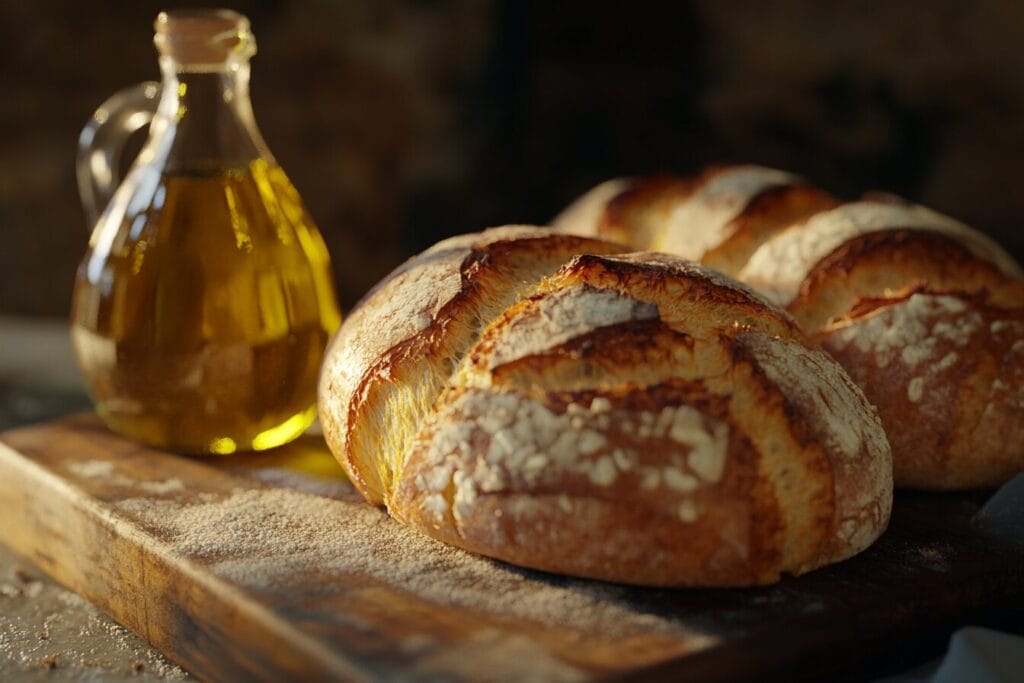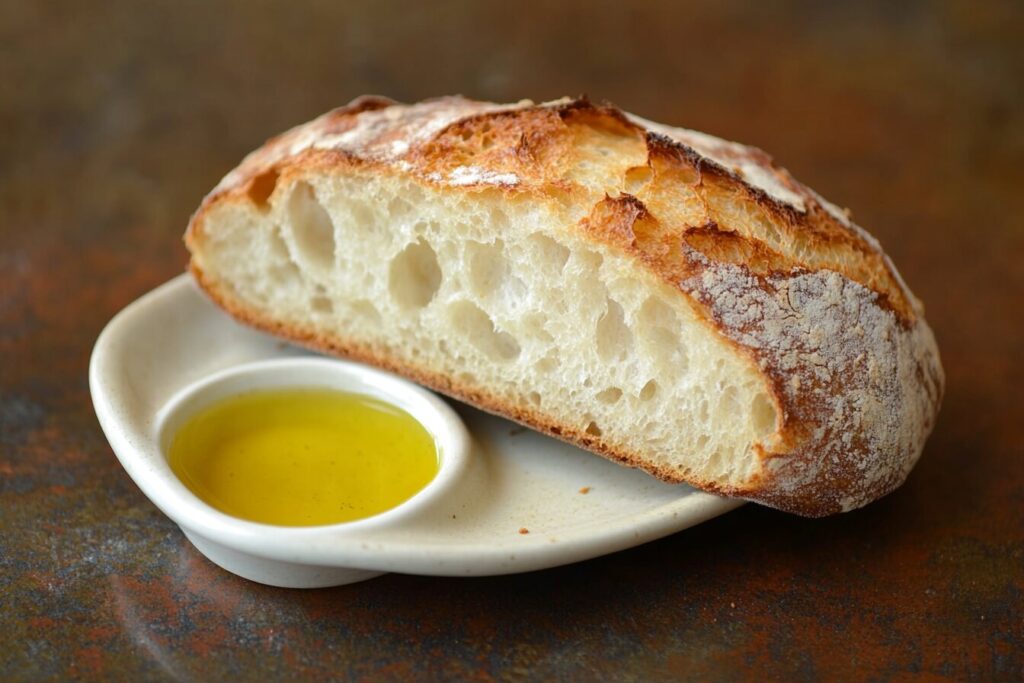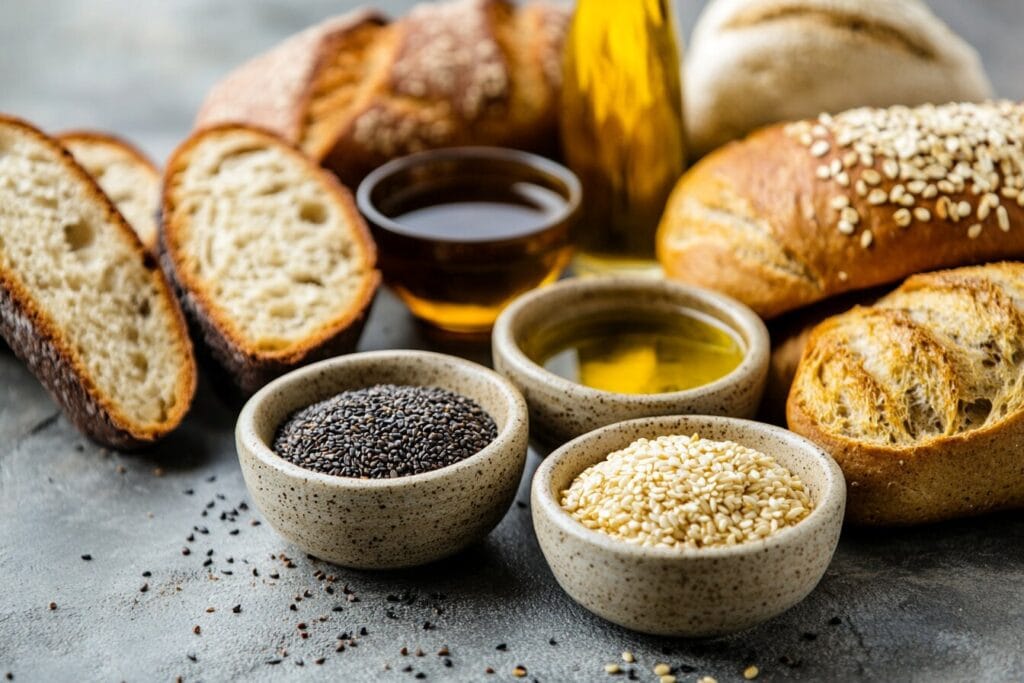Bread, one of the oldest and most beloved staples in human diets, has been made with a variety of techniques and ingredients over centuries. Among these, adding oil to bread dough is a common practice that significantly influences the final product. But what exactly does oil do in bread-making
This article delves into the science and art of bread baking, exploring how oil affects bread’s texture, flavor, shelf life, and nutritional profile. From enhancing dough elasticity to contributing a rich taste, the role of oil is both functional and flavorful. Whether you’re a seasoned baker or just starting your journey, understanding the purpose of oil in bread-making can elevate your skills and produce better results in the kitchen.

The Role of Oil in Bread Making
Bread-making is both a science and an art, with each ingredient contributing to the process and the end result. Among these ingredients, oil plays a multifaceted role in shaping the bread’s texture, flavor, and longevity. Let’s explore its functions in detail.
The Chemistry of Bread Dough
The fundamental components of bread dough—flour, water, yeast, and salt—create a robust network of gluten. Gluten, a protein found in wheat, forms an elastic structure that traps air bubbles during fermentation, enabling the dough to rise. Adding oil to this mixture modifies this network by coating the gluten strands.
This coating serves multiple purposes:
- Softens the Dough: Oil prevents the gluten from becoming overly tough, resulting in a softer crumb.
- Promotes Stretchability: By lubricating the dough, oil makes it more pliable and easier to shape.
- Regulates Moisture: It locks in moisture, preventing the dough from drying out.
The Historical Use of Oils in Baking
The use of oil in bread dates back to ancient civilizations. Olive oil, for example, was a staple in Mediterranean baking, often used to produce soft, aromatic loaves. In other regions, animal fats or nut-based oils played similar roles in bread-making traditions. These historical practices showcase the long-standing recognition of oil’s impact on bread texture and flavor.
Types of Oils Commonly Used in Bread Recipes
Different oils bring distinct qualities to bread:
- Olive Oil: Adds a fruity, aromatic flavor, ideal for focaccia or ciabatta.
- Vegetable Oil: A neutral option, suitable for a variety of bread types without altering the flavor.
- Coconut Oil: Offers a mild sweetness and works well in enriched bread like brioche.
- Canola Oil: Known for its light texture and heart-healthy profile.
- Nut Oils: Such as almond or walnut oil, which can infuse a rich, nutty flavor into artisanal loaves.
Choosing the right oil depends on the desired outcome in terms of flavor, texture, and nutritional benefits.
Effects of Adding Oil to Bread
Adding oil to bread dough significantly influences its characteristics, ranging from texture to longevity. Each of these effects contributes to the quality and appeal of the final loaf.

Enhancing Texture and Moisture
One of the most noticeable effects of oil is its ability to make bread softer and more tender. This is especially important in enriched doughs like sandwich bread, brioche, or dinner rolls. Here’s how it works:
- Soft Crumb: Oil coats the gluten strands, reducing their rigidity. This results in a tender crumb that is less chewy than bread made without oil.
- Moisture Retention: Oil creates a barrier that helps retain water in the dough, preventing the bread from drying out too quickly. This is why oil-enriched bread often stays fresh longer than lean breads like baguettes.
Improving Dough Elasticity
Oil acts as a lubricant within the dough, improving its elasticity and making it easier to work with during kneading and shaping. This effect is particularly beneficial for creating intricate bread designs or for ensuring smooth, uniform loaves.
- Stretchability: The dough becomes more pliable, which helps prevent tearing during shaping or rolling.
- Handling: Whether you’re working with sticky doughs or dense mixtures, oil reduces stickiness and enhances manageability.
Extending Shelf Life
Bread made with oil tends to stay fresh longer than bread without it. The oil slows down the staling process by inhibiting moisture loss and delaying retrogradation—a process where starch molecules crystallize and cause bread to become firm and dry.
- Softness Over Time: Oil-enriched bread maintains its soft texture for several days.
- Flavor Preservation: The presence of oil also helps retain the bread’s flavor by protecting it from oxidation.
Contributing to Crust Characteristics
While oil is primarily associated with softening the crumb, it also affects the crust.
- Golden Brown Finish: Adding oil to the dough promotes a richer browning effect during baking.
- Crispness vs. Softness: Depending on the quantity, oil can either contribute to a crisp crust or a softer, shinier surface—perfect for sandwich loaves.
- Flavor Enhancement: Certain oils, like olive or sesame oil, can add depth to the crust’s flavor, creating a more complex taste profile.
Each of these factors showcases how oil is more than just a secondary ingredient; it’s a key player in crafting a loaf’s texture, longevity, and overall appeal.
How Oil Alters Bread’s Flavor
The addition of oil to bread not only enhances its texture but also influences its taste. Depending on the type and quantity of oil used, it can subtly or significantly alter the flavor profile of the bread, making it a versatile ingredient for bakers.
Neutral Oils vs. Flavorful Oils
When it comes to flavor, oils can be categorized as either neutral or flavorful.
- Neutral Oils:
Oils like vegetable, canola, or sunflower oil have little to no distinct taste. These oils are ideal for recipes where you want the flavor of other ingredients, such as herbs, cheese, or sweeteners, to shine through. For example:- Sandwich bread made with canola oil remains mild, complementing various fillings.
- Dinner rolls with sunflower oil pair well with both savory and sweet spreads.
- Flavorful Oils:
Oils with strong, distinctive flavors, such as olive oil, coconut oil, or sesame oil, can add a unique taste to the bread.- Olive Oil: Infuses a rich, fruity aroma, commonly used in focaccia or ciabatta.
- Coconut Oil: Offers a subtle sweetness, making it popular in Hawaiian rolls or brioche.
- Sesame Oil: Imparts a nutty essence, often used in Asian-style breads or flatbreads.
Cultural Variations in Oil-Infused Bread
The type of oil used in bread often reflects regional or cultural preferences:
- Mediterranean: Olive oil is a staple in countries like Italy, Greece, and Spain, where it is used not only in dough but also brushed on top before baking for added flavor and sheen.
- Middle Eastern: Sesame oil or tahini (a sesame paste) is incorporated into breads like pita or flatbreads, providing a nutty undertone.
- Asian: Coconut oil features prominently in sweet buns or steamed bread.
- Western Baking: Neutral oils are often chosen for their adaptability in recipes like sandwich bread or enriched doughs.
These variations demonstrate how oil serves as both a functional and flavorful element in bread-making across the globe.

Balancing Oil and Other Ingredients
While oil can add richness and depth to bread’s flavor, it’s important to balance it with other ingredients. Too much oil can overpower the natural flavors of the flour, yeast, and any added seasonings. Here are some tips:
- Use in Moderation: Start with the recommended quantity and adjust as needed. A typical ratio is 2–3 tablespoons of oil per loaf.
- Pair with Complementary Ingredients: For instance, olive oil pairs well with rosemary or garlic, while coconut oil complements tropical flavors like pineapple or mango.
- Experiment with Infused Oils: Garlic-infused olive oil or chili-infused sesame oil can add complexity to your bread recipes.
By carefully selecting and balancing oils, bakers can craft bread with a distinctive and satisfying flavor profile.
Health Considerations When Using Oil in Bread
Adding oil to bread not only affects its texture and flavor but also has implications for its nutritional profile. Understanding the health aspects of using oil can help bakers make informed choices, especially for health-conscious recipes.
Nutritional Value of Oils
Different types of oils offer varying levels of fats, vitamins, and antioxidants, which can contribute to the bread’s overall nutritional benefits.
- Olive Oil: Rich in monounsaturated fats and antioxidants, olive oil is associated with heart health and reduced inflammation. It’s an excellent choice for Mediterranean-inspired bread.
- Canola Oil: Known for its low saturated fat content and omega-3 fatty acids, canola oil is a healthier neutral option.
- Coconut Oil: Contains medium-chain triglycerides (MCTs), which are easier to digest and can provide a quick energy source, but it’s high in saturated fats.
- Avocado Oil: Packed with vitamin E and monounsaturated fats, this oil is both heart-healthy and flavorful.
- Nut Oils (e.g., Walnut, Almond): High in omega-3 fatty acids and vitamins, nut oils add nutritional value but should be used sparingly due to their concentrated fat content.
Balancing Fats in Your Diet
While oils can improve bread’s texture and taste, they are also calorie-dense. Moderation is key to incorporating them into a balanced diet.
- Caloric Impact: A single tablespoon of oil adds approximately 120 calories. For those watching their calorie intake, using less oil or opting for lower-fat alternatives can help.
- Portion Control: Slicing bread into smaller portions can make it easier to enjoy oil-enriched bread without overindulging.
- Complementary Ingredients: Pairing oil-enriched bread with healthy toppings like hummus, avocado, or fresh vegetables can make for a nutritious meal.
Oil Substitutes for Health-Conscious Bakers
If you’re looking to reduce the fat content in your bread recipes, consider these substitutes:
- Applesauce: Adds moisture and a touch of sweetness, making it ideal for sweet bread recipes.
- Greek Yogurt: Provides creaminess and moisture while adding protein.
- Mashed Avocado: A healthy fat substitute with a rich texture and flavor.
- Buttermilk: Offers a creamy texture and slightly tangy taste, especially in whole-grain bread.
Understanding Oil-Free Breads
Some breads, like baguettes or sourdough, are traditionally made without oil. These lean breads rely on water and flour to create their characteristic chewy texture and crispy crust. However, they tend to stale more quickly than oil-enriched loaves, making them less ideal for long-term storage.
Striking the Right Balance
To achieve a balance between health and flavor:
- Use High-Quality Oils: Opt for extra-virgin olive oil, cold-pressed oils, or organic options to maximize health benefits.
- Measure Accurately: Avoid adding more oil than the recipe requires.
- Incorporate Whole Grains: Pairing oil-enriched bread with whole-grain flours can improve the bread’s fiber content, adding to its health value.
Health-conscious baking doesn’t mean sacrificing taste or texture. By choosing the right oils and substitutes, bakers can create breads that are both delicious and nutritious.
Tips for Using Oil in Bread Recipes
Incorporating oil into bread recipes requires a balance of technique and creativity. Here are some tips to maximize the benefits of adding oil to your dough.
Choosing the Right Type and Quantity
- Select the Oil Based on the Recipe:
- Use neutral oils like vegetable or canola for everyday sandwich loaves.
- Choose flavorful oils, such as olive or sesame oil, for artisanal breads where the oil’s taste can shine.
- Stick to Recommended Quantities:
- Too much oil can make the bread heavy and greasy.
- Most recipes call for 2–3 tablespoons per loaf, which is sufficient to achieve a tender crumb without overpowering other ingredients.
Mixing Techniques for Optimal Results
Adding oil at the right stage of bread-making is crucial:
- During Kneading: For even distribution, gradually incorporate oil while kneading the dough. This ensures that it blends seamlessly with the other ingredients.
- In Enriched Doughs: Mix the oil with wet ingredients (like milk or eggs) before combining them with dry ingredients for smoother integration.
Experimenting with Flavored Oils
Infused oils can elevate the taste of your bread:
- Herb-Infused Oils: Use oils flavored with rosemary, thyme, or garlic for savory loaves.
- Spiced Oils: Add warmth and complexity with chili or cumin-infused oils.
- Sweet Flavors: For sweet breads, consider oils infused with vanilla, cinnamon, or citrus zest.
These variations can help you create unique bread recipes tailored to specific occasions or preferences.
Troubleshooting Common Issues with Oil in Bread
- Greasy Texture: Reduce the amount of oil or incorporate it more slowly during mixing.
- Flat Loaf: Overuse of oil can weigh down the dough. Stick to the recipe’s guidelines.
- Uneven Flavor: Use high-quality, fresh oils to avoid a rancid or off taste.
FAQs
Does oil make bread softer?
Yes, oil makes bread softer by coating the gluten strands in the dough, which reduces rigidity and creates a tender crumb. It also helps retain moisture, keeping the bread fresher for longer.
Can you replace butter with oil in bread recipes?
Yes, oil can often replace butter in bread recipes. Use a 3:4 ratio (3 parts oil for 4 parts butter) since oil is 100% fat, while butter contains water and milk solids. For instance, use ¾ cup of oil to replace 1 cup of butter.
What happens if you add too much oil?
Excess oil can make the bread dense, greasy, and less likely to rise properly. It can also alter the flavor, potentially overpowering other ingredients.
Which oil is best for bread baking?
The best oil depends on the recipe and desired flavor. Olive oil works well for Mediterranean bread, while neutral oils like canola are better for sandwich loaves. Coconut oil is ideal for sweet breads.
How does oil compare to other fats like butter or shortening?
Oil creates a softer crumb and enhances moisture retention, while butter adds richness and flavor. Shortening produces a flaky texture but lacks the flavor of butter or oil.
Can you make bread without oil?
Yes, bread can be made without oil. Lean bread recipes like baguettes or sourdough don’t include oil, relying on flour, water, yeast, and salt for their structure and texture.
Conclusion
Oil is a versatile and transformative ingredient in bread-making, enhancing texture, flavor, and shelf life. Whether you’re using a neutral oil to let other flavors shine or a flavorful oil to add complexity, understanding its role can elevate your baking. From softening the crumb to contributing to the crust’s character, oil brings both functionality and flair to your loaves.
By experimenting with different types of oils and techniques, you can create bread that caters to your preferences, whether you prioritize taste, texture, or health. Embrace the possibilities of oil in bread-making and enjoy the results of your delicious, well-informed efforts!

